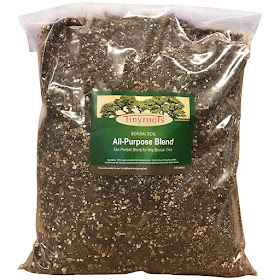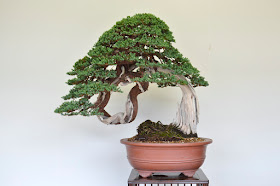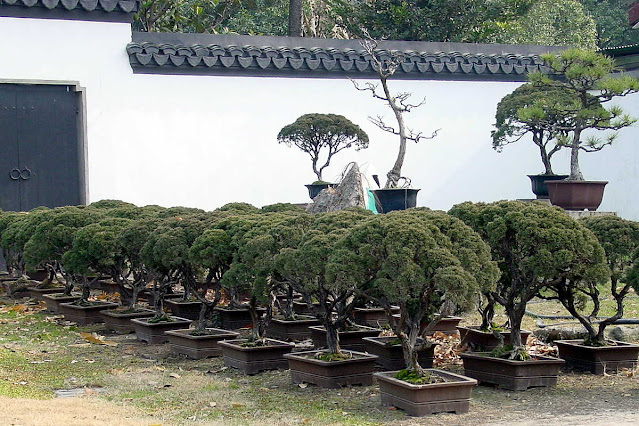The Juniper Bonsai also known as Juniperus is one of the most popular Bonsai trees. Junipers can be found in all shape and sizes around throughout the world of Bonsai. Juniper Bonsai trees sold at large stores, including Walmart and Home Depot, are often Japanese Garden Junipers, also called Green Mound Junipers (Juniperus procumbens nana). Other popular species are the Chinese juniper (Juniperus chinensis ), the Japanese Shimpaku
), the Japanese Shimpaku (Juniperus sargentii), the Japanese needle juniper (Juniperus rigida
(Juniperus sargentii), the Japanese needle juniper (Juniperus rigida ), two central European species: the savin (Juniperus sabina) and the common juniper (Juniperus communis), and three American species: the California Juniper (Juniperus californica), the Rocky mountain Juniper (Juniperus scopulorum) and the Sierra Juniper (Juniperus occidentalis). The foliage colors range from dark blue-greens to light greens and the foliage can either be scale-like or needle-like. Scale junipers usually have needle-like foliage when they are young (called juvenile foliage), the typical scale-like foliage appears later. After heavy pruning or bending, overwatering or other stress often juvenile foliage will grow again. It can last a few years until enough normal scale-like foliage has grown and all the needle-like foliage can be removed.
), two central European species: the savin (Juniperus sabina) and the common juniper (Juniperus communis), and three American species: the California Juniper (Juniperus californica), the Rocky mountain Juniper (Juniperus scopulorum) and the Sierra Juniper (Juniperus occidentalis). The foliage colors range from dark blue-greens to light greens and the foliage can either be scale-like or needle-like. Scale junipers usually have needle-like foliage when they are young (called juvenile foliage), the typical scale-like foliage appears later. After heavy pruning or bending, overwatering or other stress often juvenile foliage will grow again. It can last a few years until enough normal scale-like foliage has grown and all the needle-like foliage can be removed.
 |
| Bonsai Tree Soil Potting Mix Blend |
The berry-like cones are round or oval, depending on the species they measure between 3 mm and 2 cm and they need a year or two to ripen. The seeds are round or edged. The cones are often eaten by birds who spread the germinable seeds later with their droppings.
Junipers are very suitable for creating deadwood (jin and shari). This is due to the fact that live veins below a broken or for other reasons dying branch will dry out and die. This results in natural deadwood which is peeled, polished and bleached by climatic conditions and is very durable in case of the juniper. The triad of green foliage, reddish-brown or yellowish-brown bark and silvery white deadwood is very appealing.
Position: Place the tree outside, year-round, on a bright spot with lots of sunlight. The Juniper cannot live indoors. During the winter protect the tree once temperatures drop below -10 degrees C (14F). Some species change their foliage color during frosty periods to a purplish brown which is connected with their frost protection mechanism. In spring they will turn green again.
Watering: Be careful not to water too much, as the juniper roots don't like soil wetness. Before you water, the soil should dry well. Misting the tree can be done regularly, especially after the tree has been repotted because it benefits from air humidity. Continue reading about watering Bonsai trees.
Feeding: Use normal organic fertilizer pellets or balls every month during the growth season or a liquid fertilizer each week. If strong growth is desired some higher nitrogen levels can be applied in spring.
Pruning: To develop the foliage pads, long shoots which stick out of the silhouette can be pinched or cut at the base with sharp scissors throughout the growth season. Do not trim the juniper like a hedge because the removal of all growing tips will weaken the tree and the cut will turn the needles brown. When the foliage pads become too dense they must be thinned out with sharp scissors at the base. The Juniper Bonsai is generally a strong tree that also withstands aggressive pruning quite well. But it cannot bud again from bare tree parts, so take care that there is some foliage left on every branch you want to keep alive. Continue reading about pruning Bonsai trees .
.
Wiring: Junipers which are produced for Bonsai purposes are already wired quite heavily in most cases when they are still very young. Dramatically twisted shapes are very popular and correspond with the natural shapes that used to grow in the Japanese mountains in former times. Junipers can be strongly bent, if necessary wrapped with raffia or tape as a protection, but you must be careful with parts that possess deadwood. Those parts break easily. If they are large and old, you can split the deadwood off in order to bend the more flexible living parts. The foliage pads should be wired and fanned out after thinning when necessary, to let light and air get in. Otherwise, the inner parts of the foliage pads will die. In addition to this, the danger of pest infestation is increased if the pads are too dense. From the aesthetic point of view, we also want to achieve unobstructed structures and want to prevent the juniper from looking like broccoli.
Re-potting: Once every two years, very old trees at longer intervals, using a basic (or somewhat more draining) soil mixture . Don't prune the roots too aggressively. I'd suggest the Bonsai potting soil mixture, click here for customer review details on Amazon.
. Don't prune the roots too aggressively. I'd suggest the Bonsai potting soil mixture, click here for customer review details on Amazon.
Propagation: Use seeds or cuttings.
Acquisition of juniper Bonsai: Many well-suited juniper species in different sizes are offered in most nurseries. You can often find good Bonsai raw material there. In gardens, concrete pots and on cemeteries on old graves that will be cleared there are often quite old junipers and if you are lucky the owner will allow you to dig one out for little money or a new plant. Specialized Bonsai traders offer everything from young plants, pre-Bonsai and pre-styled juniper trees up to high-value Bonsai, in various styles and shapes.
 |
| Kiyonal bonsai healing cream, click here for more details |
Pests/diseases: If junipers are well cared for and placed in an ideal position they are quite resistantwebworms for example. Customary insecticide/miticide sprays
for example. Customary insecticide/miticide sprays will help but you should also find the reason why the tree was prone to infestation. A big problem is fungal rust diseases. The diverse juniper species and cultivars have very different levels of susceptibility to rust fungus, there are also some which are regarded as resistant. As a rule of thumb, the blue-green junipers are more resistant than those with yellowish-green foliage. The Japanese junipers are also not infested very often. In the internet, you can find files which list many juniper species and cultivars and their susceptibility/resistance level to rust fungus. The rust fungus
will help but you should also find the reason why the tree was prone to infestation. A big problem is fungal rust diseases. The diverse juniper species and cultivars have very different levels of susceptibility to rust fungus, there are also some which are regarded as resistant. As a rule of thumb, the blue-green junipers are more resistant than those with yellowish-green foliage. The Japanese junipers are also not infested very often. In the internet, you can find files which list many juniper species and cultivars and their susceptibility/resistance level to rust fungus. The rust fungus infests the junipers permanently and causes swellings from which hard, brown galls emerge. In spring, during rainy weather, the galls produce large, orange, gelatin-like tendrils, full of spores, which infest the leaves of pear trees (but there are also types of rust fungus which use hawthorn or crabapples as a second host instead of the pear). The fungus causes orange spots on the pear leaves. In late summer brownish proliferation's grow from the bottom-sides of the leaves which release spores that infest junipers again. While the pear trees in most cases are not fatally affected – they are newly infested each year again and they can even be treated successfully with a fungicide, an infested juniper normally cannot be cured. (You may want to refer to my previous blogpost on Cure and Prevention for Bonsai Tree diseases) The visibly infested branches die in most cases and the fungus can emerge on other tree parts. Removing the parts with the swellings and galls is no guarantee at all that the fungus will not reappear. Although some people have a different opinion, it is best to immediately burn up a rust-infested juniper or put it into the garbage instead of your compost heap. It is important though not to let the foliage pads get too dense, because otherwise pests can settle in them more easily. During winter the junipers must be kept in a place with enough light and they must be checked for pests regularly because pests can even occur in winter. Junipers can sometimes get infested with spider mites, juniper scale, juniper aphids and juniper needle miners as well as juniper.
infests the junipers permanently and causes swellings from which hard, brown galls emerge. In spring, during rainy weather, the galls produce large, orange, gelatin-like tendrils, full of spores, which infest the leaves of pear trees (but there are also types of rust fungus which use hawthorn or crabapples as a second host instead of the pear). The fungus causes orange spots on the pear leaves. In late summer brownish proliferation's grow from the bottom-sides of the leaves which release spores that infest junipers again. While the pear trees in most cases are not fatally affected – they are newly infested each year again and they can even be treated successfully with a fungicide, an infested juniper normally cannot be cured. (You may want to refer to my previous blogpost on Cure and Prevention for Bonsai Tree diseases) The visibly infested branches die in most cases and the fungus can emerge on other tree parts. Removing the parts with the swellings and galls is no guarantee at all that the fungus will not reappear. Although some people have a different opinion, it is best to immediately burn up a rust-infested juniper or put it into the garbage instead of your compost heap. It is important though not to let the foliage pads get too dense, because otherwise pests can settle in them more easily. During winter the junipers must be kept in a place with enough light and they must be checked for pests regularly because pests can even occur in winter. Junipers can sometimes get infested with spider mites, juniper scale, juniper aphids and juniper needle miners as well as juniper.
Interesting Books on Bonsai can be found here:
The Complete Book of Bonsai --> I've been into bonsai for 25 years and this is the basic Bible for beginner and intermediate bonsai enthusiasts. It has an excellent section on techniques, including pruning, wiring and whatnot, and it has a large species-specific tree guide. If you're into bonsai and want only one book, this is it.
Indoor Bonsai The Great Selection --> Creating beautiful, healthy bonsai is a wonderful skill that anyone can learn, with a little time, patience, and this all-inclusive manual. With color photos and drawings to illustrate the points, it introduces all the cultivation techniques; offers expert advice on location, soil types, watering, and pest control; and provides intricate instruction on training the bonsai--including pruning, wiring, and stretching it.
The Secret Techniques of Bonsai --> In The Secret Techniques of Bonsai, the author of the groundbreaking Bonsai With American Trees teams up with his son to offer not only the basics for creating perfect bonsai, but also secret techniques they’ve developed over years of careful work and observation.
Bonsai Survival Manual --> Problem solving when your Bonsai get sick. Expand your gardening repertoire as you create a captivating and exquisite miniature world. In this introductory guide, Colin Lewis covers everything you need to know to design, grow, and successfully maintain attractive bonsai.
Bonsai and the art of Penjing --> Bonsai & Penjing, Ambassadors of Beauty and Peace describes how Chinese penjing and North American bonsai were later added to the Museum, making its collection the most comprehensive in the world. Stories of individual trees and forest plantings are featured, as are the roles played by the skilled and talented creators of these living art forms people such as John Naka, Saburo Kato, Yuji Yoshimura, Harry Hirao, and Dr. Yee-Sun Wu.
Bonsai and the art of Penjing --> Bonsai & Penjing, Ambassadors of Beauty and Peace describes how Chinese penjing and North American bonsai were later added to the Museum, making its collection the most comprehensive in the world. Stories of individual trees and forest plantings are featured, as are the roles played by the skilled and talented creators of these living art forms people such as John Naka, Saburo Kato, Yuji Yoshimura, Harry Hirao, and Dr. Yee-Sun Wu.
Bonsai with Japanese Maples --> With their delicate foliage, seasonal color changes, and intricate pattern of branching, Japanese maples are among the most popular and suitable plants for bonsai design. In this long-awaited book, internationally renowned expert Peter Adams discusses both the specific horticultural needs of Japanese maples as bonsai subjects and illustrates proven techniques for creating and maintaining beautiful specimens.
The Modern Bonsai Practice --> The most current, useful information on growing Bonsai. Fresh, practical, definitive, comprehensive reference guide to the finest art of horticulture: growing miniature trees. Common sense bonsai answers separating myth from fact with depth and detail. Appropriate for both bonsai hobbyists and experienced practitioners.

More Bonsai articles can be found here:
Please click here for more information on --> Chinese Penjing Bonsai
Please click here for more information on --> The Origins of Bonsai
Please click here for more information on --> The Art of Saikei Bonsai
Please click here for more information on --> Japanese Tanuki Bonsai
Please click here for more information on --> How to Water a Bonsai
Please click here for more information on --> Bonsai Healing Methods
Thank you for visiting my blog and feel free to subscribe or leave your message at the comment section below. Please always remember, good feedback or bad remarks, it doesn't matter!


